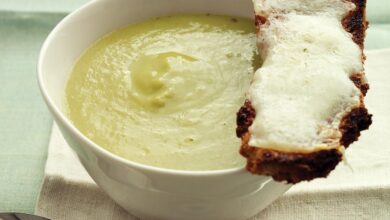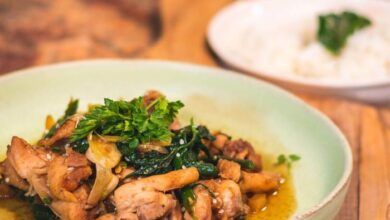
Tom Yum Koong Soup: A Culinary Journey Through Thailand
Tom yum koong soup, a vibrant and aromatic dish, is a true testament to the culinary prowess of Thailand. This iconic soup, with its roots deeply embedded in Thai history and culture, is a symphony of flavors that tantalizes the taste buds and warms the soul.
The origins of tom yum koong can be traced back centuries, with its evolution influenced by a blend of indigenous ingredients and techniques, along with culinary exchanges with neighboring countries. This complex history is reflected in the soup’s unique flavor profile, a captivating blend of sweet, sour, spicy, and savory notes that are both invigorating and comforting.
Origins and History
Tom Yum Koong, a fiery and aromatic Thai soup, has a rich history interwoven with the cultural tapestry of Thailand. Its origins can be traced back to the ancient traditions of Thai cuisine, where the use of herbs, spices, and fresh ingredients played a vital role in creating flavorful and nutritious dishes.
Evolution of Tom Yum Koong
The evolution of Tom Yum Koong can be attributed to the influences of various cultures and culinary traditions. Early forms of the soup were likely simpler, using ingredients readily available in the region. Over time, as trade and cultural exchange flourished, new ingredients and techniques were introduced, leading to the complex and flavorful soup we know today.
- Ancient Origins:The origins of Tom Yum Koong can be traced back to the ancient Thai tradition of using herbs, spices, and fresh ingredients in their cooking. Early forms of the soup were likely simpler, using ingredients like lemongrass, galangal, and chilies.
- Influence of Chinese Cuisine:The arrival of Chinese immigrants in Thailand brought with them their culinary traditions, including the use of soy sauce and fish sauce. These ingredients were incorporated into Tom Yum Koong, adding a savory and umami depth to the soup.
- Influence of Malay Cuisine:Malay cuisine also played a role in the evolution of Tom Yum Koong. The use of coconut milk, a staple ingredient in Malay cuisine, was introduced into the soup, adding a creamy and rich texture.
- Modern Adaptations:In modern times, Tom Yum Koong has undergone further adaptations, with variations incorporating ingredients like mushrooms, seafood, and vegetables. The soup has also become popular in other parts of Southeast Asia and around the world.
Ingredients and Preparation: Tom Yum Koong Soup
Tom Yum Koong, a vibrant and aromatic Thai soup, boasts a symphony of flavors that dance on the palate. Its unique blend of ingredients, both fresh and fragrant, creates a culinary masterpiece that is both refreshing and satisfying. The preparation of this soup involves a meticulous process that balances the delicate interplay of flavors, resulting in a truly authentic experience.
Tom yum koong soup, with its vibrant flavors and spicy kick, is a classic Thai dish that always hits the spot. If you’re looking for a delicious and easy main course to pair with it, try this easy slow cooker sweet and sour pork chops recipe.
The sweet and tangy sauce complements the soup beautifully, creating a satisfying and balanced meal.
Ingredients of Tom Yum Koong
The foundation of Tom Yum Koong lies in its carefully chosen ingredients, each playing a vital role in shaping its distinctive taste. The soup’s unique flavor profile is a testament to the meticulous selection and balance of these elements.
- Shrimp:The star of the show, shrimp adds a delicate sweetness and a satisfying texture to the soup. The use of fresh, high-quality shrimp is crucial for achieving the optimal flavor and aroma.
- Lemongrass:This aromatic herb provides a citrusy, pungent note that adds a refreshing touch to the soup. The lemongrass is typically bruised and then simmered in the broth, releasing its essential oils and creating a vibrant aroma.
- Galangal:This ginger-like root adds a subtle, earthy, and slightly peppery flavor to the soup. Galangal is known for its digestive properties and its ability to enhance the overall complexity of the dish.
- Kaffir Lime Leaves:These aromatic leaves contribute a citrusy, floral aroma and a slightly bitter flavor to the soup. They are typically torn into pieces and added during the simmering process, infusing the broth with their unique fragrance.
- Chili Peppers:The level of heat in Tom Yum Koong is determined by the type and amount of chili peppers used. Bird’s eye chilies, known for their intense heat, are commonly used, while other varieties like Thai chilies can be substituted depending on preference.
- Fish Sauce:This fermented fish sauce adds a savory, umami depth to the soup. The use of high-quality fish sauce is essential for achieving the authentic flavor profile of Tom Yum Koong.
- Lime Juice:The acidity of lime juice balances the richness of the broth and adds a bright, refreshing note to the soup.
- Sugar:A small amount of sugar is used to balance the acidity of the lime juice and enhance the overall harmony of flavors.
- Coconut Milk:The addition of coconut milk creates a creamy, luxurious texture and adds a subtle sweetness to the soup.
- Mushrooms:Mushrooms, such as shiitake or oyster mushrooms, add a savory, earthy flavor and a delightful textural element to the soup.
- Tomatoes:Tomatoes contribute a tangy, sweet flavor and a vibrant color to the soup.
- Cilantro:Fresh cilantro is added at the end of the cooking process to provide a refreshing, herbaceous aroma and a bright, green color to the soup.
Preparation of Tom Yum Koong
The preparation of Tom Yum Koong is a delicate process that involves carefully combining the ingredients to achieve the perfect balance of flavors. The following steps provide a comprehensive guide to preparing this classic Thai soup.
- Prepare the Broth:Start by preparing the flavorful broth. In a large pot, bring water to a boil. Add lemongrass, galangal, kaffir lime leaves, and chili peppers to the boiling water. Reduce the heat and simmer for about 15 minutes to allow the flavors to infuse into the broth.
- Add the Shrimp:Once the broth has simmered, add the shrimp to the pot and cook until they turn pink and opaque, about 2-3 minutes. Remove the shrimp from the pot and set aside.
- Season the Broth:Add fish sauce, lime juice, and sugar to the broth. Taste and adjust the seasoning as needed.
- Add the Remaining Ingredients:Add the mushrooms, tomatoes, and coconut milk to the broth. Bring the soup to a simmer and cook for about 5 minutes.
- Finish the Soup:Return the shrimp to the pot and simmer for another minute. Garnish with fresh cilantro and serve immediately.
Flavor Profile and Characteristics
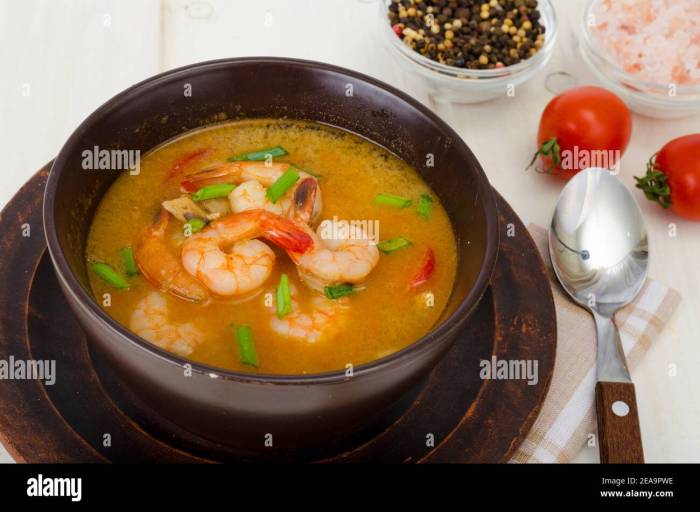
Tom Yum Koong, with its vibrant red hue and fragrant aroma, is a symphony of contrasting flavors that tantalize the taste buds. The soup’s unique character stems from a masterful balance of sweet, sour, spicy, and savory notes, creating a culinary masterpiece that is both comforting and invigorating.
The Essence of Tom Yum Koong
The complexity of Tom Yum Koong’s flavor profile arises from the interplay of its key ingredients. The foundation of the soup is a rich broth infused with lemongrass, galangal, kaffir lime leaves, and chilies. This aromatic blend creates a base that is both spicy and citrusy, with subtle earthy notes.
Tom yum koong soup, with its vibrant flavors and spicy kick, always reminds me of a warm summer evening. It’s a dish that’s both comforting and invigorating, just like a slice of caleys classic zucchini bread on a cool autumn day.
The sweetness of the zucchini bread, combined with the spice of the tom yum koong, creates a perfect balance of flavors that I can’t resist.
The addition of fish sauce and lime juice adds a salty and tangy dimension, while the sweetness comes from palm sugar or sugar. The star ingredient, prawns, contribute a delicate seafood flavor that complements the overall taste profile.
Balance of Flavors
- Sweetness:Palm sugar or sugar adds a gentle sweetness that balances the sour and spicy notes. This sweetness is not overpowering but rather acts as a counterpoint to the other flavors.
- Sourness:Lime juice provides a sharp and tangy sourness that brightens the soup and cuts through the richness of the broth. It also helps to enhance the flavors of the other ingredients.
- Spice:Chilies, typically bird’s eye chilies, provide a fiery kick that awakens the palate. The level of spice can be adjusted to individual preference.
- Savory:Fish sauce adds a depth of savory flavor that rounds out the soup’s profile. It also enhances the natural sweetness of the prawns.
Influence of Ingredients
- Lemongrass:This fragrant herb adds a citrusy and slightly lemony flavor, along with a subtle hint of earthiness.
- Galangal:This ginger-like root contributes a warm, spicy, and slightly peppery flavor to the soup.
- Kaffir Lime Leaves:These leaves impart a unique aroma and flavor that is both citrusy and floral.
- Chilies:The type and amount of chili used determine the level of heat in the soup. Bird’s eye chilies are commonly used for their intense spiciness.
- Prawns:The prawns provide a delicate seafood flavor that complements the other ingredients.
Variations and Regional Differences
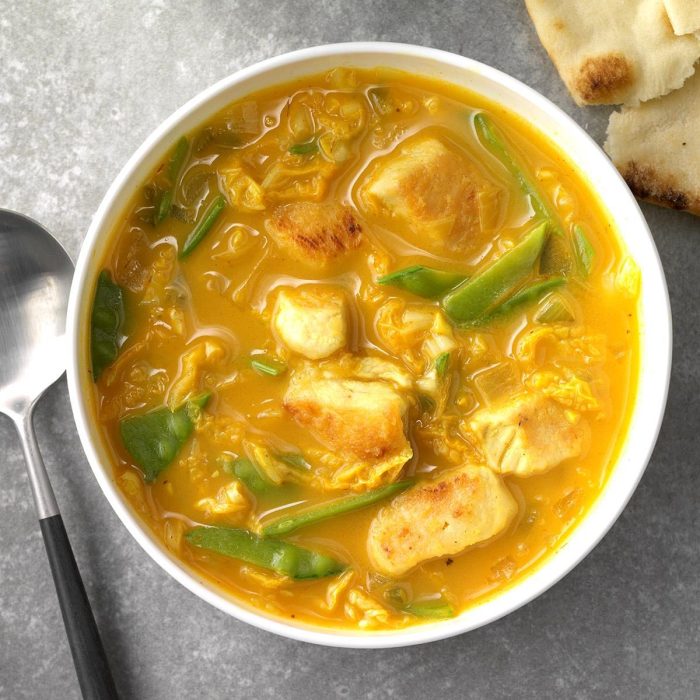
Tom Yum Koong, like many beloved dishes, has evolved over time, adapting to regional preferences and local ingredients. This has resulted in a delightful array of variations, each with its own unique flavor profile.
Regional Variations
The diverse regions of Thailand have contributed to the variations in Tom Yum Koong. Each region boasts unique ingredients and cooking styles that influence the soup’s taste.
- Northern Thailand:Known for its mountainous terrain, Northern Thailand often incorporates ingredients like wild mushrooms, lemongrass, and galangal into their Tom Yum Koong. The use of these ingredients adds an earthy and aromatic complexity to the soup.
- Northeastern Thailand:This region, also known as Isan, is known for its spicy and sour flavors. The Tom Yum Koong in this region often features a higher concentration of chilies, giving it a fiery kick.
- Central Thailand:The heart of Thailand, Central Thailand, is home to the most common version of Tom Yum Koong. This version features a balance of sour, spicy, and savory flavors, with a focus on fresh seafood and fragrant herbs.
- Southern Thailand:Influenced by Malay cuisine, Southern Thailand’s Tom Yum Koong often incorporates ingredients like turmeric, lemongrass, and kaffir lime leaves. This adds a unique blend of sweet, savory, and citrusy notes to the soup.
Regional Ingredients
The specific ingredients used in Tom Yum Koong can vary depending on the region and availability. Here are some examples:
- Lemongrass:A key ingredient in Tom Yum Koong, lemongrass is used for its fragrant citrusy aroma. However, the specific variety of lemongrass can vary depending on the region. For instance, Northern Thailand may use a different variety with a stronger aroma than Central Thailand.
- Galangal:Another important ingredient, galangal, is a rhizome with a spicy and slightly peppery flavor. The amount of galangal used can vary, with some regions preferring a more pronounced flavor than others.
- Chilies:The type and quantity of chilies used can significantly affect the spiciness of the soup. Northern Thailand may use bird’s eye chilies for a more intense heat, while Central Thailand may opt for milder chilies.
- Seafood:The type of seafood used in Tom Yum Koong can also vary. While prawns are the most common, other seafood like fish, crab, or squid may be used depending on regional preferences and availability.
Flavor Profiles
The regional variations in Tom Yum Koong result in distinct flavor profiles.
- Northern Thailand:Tom Yum Koong from Northern Thailand is known for its earthy and aromatic flavors, with a subtle spiciness. The use of wild mushrooms and lemongrass adds a unique depth to the soup.
- Northeastern Thailand:Tom Yum Koong from Northeastern Thailand is characterized by its fiery spiciness and sourness. The higher concentration of chilies gives it a bold and intense flavor.
- Central Thailand:The most common version of Tom Yum Koong, the Central Thai version, offers a balanced flavor profile with a good balance of sour, spicy, and savory notes. It is known for its fresh seafood and fragrant herbs.
- Southern Thailand:Tom Yum Koong from Southern Thailand has a unique blend of sweet, savory, and citrusy flavors. The use of turmeric, lemongrass, and kaffir lime leaves adds a distinct complexity to the soup.
Culinary Significance and Cultural Context
Tom Yum Koong holds a significant place in Thai cuisine, representing not just a flavorful dish but also a cultural symbol deeply intertwined with the nation’s history and identity. Its popularity transcends mere taste; it embodies a sense of national pride and reflects the rich culinary traditions of Thailand.
Role in Thai Cultural Events and Celebrations
Tom Yum Koong is a staple at various Thai cultural events and celebrations, showcasing its versatility and symbolic significance. It is often served during special occasions like weddings, birthdays, and festivals, adding a touch of vibrancy and festivity to the gatherings.
- Weddings:Tom Yum Koong is commonly served during wedding receptions, representing a wish for prosperity and good fortune for the newly married couple. Its bright, tangy flavor is believed to bring joy and auspiciousness to the occasion.
- Birthdays:The dish is often included in birthday feasts, symbolizing a wish for good health and a long life for the celebrant. Its spicy and sour notes are believed to ward off evil spirits and bring good luck.
- Festivals:Tom Yum Koong is a popular choice during festivals like Songkran (Thai New Year), where it is served alongside other traditional dishes, representing the celebration of new beginnings and the renewal of life.
Social and Cultural Context
Tom Yum Koong transcends its role as a mere dish; it represents a cultural identity and social interaction in Thai society.
- Shared Meals:The dish often serves as a symbol of community and shared experiences. In Thai culture, sharing meals is an integral part of social interaction, fostering connections and strengthening relationships. Tom Yum Koong, with its unique flavor profile, is often a centerpiece of these shared meals.
- Home Cooking:Tom Yum Koong is a popular home-cooked dish, reflecting the culinary skills and traditions passed down through generations. It is a dish that brings families and friends together, fostering a sense of warmth and belonging.
- National Pride:The dish has become a symbol of Thai culinary heritage, representing the nation’s rich culinary traditions and creativity. Its popularity has spread globally, becoming a culinary ambassador for Thailand, promoting its unique flavors and culture.
Nutritional Value and Health Benefits
Tom Yum Koong, with its vibrant flavors and aromatic spices, is not only a culinary delight but also a nutritional powerhouse. This traditional Thai soup offers a diverse range of vitamins, minerals, and antioxidants, contributing to various health benefits.
Tom yum koong soup, with its fiery spice and tangy lemongrass, is a taste explosion that always leaves me wanting more. But sometimes, I crave something lighter and more brunch-worthy, like a perfectly ripe avocado smashed on toast with a runny egg.
If you’re looking for a recipe that’s both delicious and easy to make, check out this avocado toast with egg recipe, it’s a real winner! Then, after you’ve enjoyed your toast, you can dive back into that spicy, fragrant bowl of tom yum koong for a truly satisfying meal.
Nutritional Composition of Tom Yum Koong
The nutritional content of Tom Yum Koong varies depending on the specific ingredients and quantities used. However, a typical serving of this soup provides a good source of protein, vitamins, and minerals, including:
- Protein:From shrimp, mushrooms, and lemongrass.
- Vitamins:Vitamin C from lime juice, vitamin A from chilies, and vitamin B complex from mushrooms.
- Minerals:Calcium from shrimp, potassium from coconut milk, and iron from lemongrass.
- Antioxidants:Galangal, kaffir lime leaves, and chilies are rich in antioxidants that help combat free radical damage.
Potential Health Benefits
The diverse nutritional profile of Tom Yum Koong offers several potential health benefits:
- Boosts Immunity:The high vitamin C content from lime juice supports the immune system, protecting against infections.
- Supports Digestive Health:Lemongrass and galangal aid digestion, reducing bloating and promoting gut health.
- Anti-Inflammatory Properties:Galangal and chilies possess anti-inflammatory properties, potentially reducing inflammation in the body.
- May Help Manage Blood Sugar:The fiber content from mushrooms can help regulate blood sugar levels.
Dietary Considerations
While Tom Yum Koong is generally considered a healthy dish, certain dietary considerations should be taken into account:
- Seafood Allergies:Individuals with shellfish allergies should avoid this soup due to the presence of shrimp.
- Sodium Content:The use of fish sauce and soy sauce can contribute to a higher sodium content, so those on a low-sodium diet should be mindful of their intake.
- Spice Level:The chili content can be adjusted to suit individual spice tolerance.
- Coconut Milk:Individuals with coconut allergies should avoid this soup.
Serving and Presentation
Tom Yum Koong, with its vibrant colors and fragrant aromas, is a dish that demands a visually appealing presentation. The way you serve this soup can enhance its overall appeal and dining experience.
Common Serving Methods
There are various ways to serve Tom Yum Koong, each offering a unique presentation and dining experience.
- Individual Bowls:This is the most common way to serve Tom Yum Koong, allowing each diner to enjoy their own portion. It’s perfect for casual dining or when serving a small group.
- Sharing Bowls:Larger bowls are ideal for serving a group of people, allowing them to share the soup and enjoy the flavors together.
- Soup Tureen:A soup tureen adds a touch of elegance and formality to the presentation. It’s suitable for special occasions or when hosting a dinner party.
Visual Presentation
The visual presentation of Tom Yum Koong is as important as its taste. Here are some tips to elevate the dish:
- Color Contrast:The vibrant colors of the soup, including the red chili, green lemongrass, and white shrimp, create a visually appealing contrast. Consider garnishing with fresh cilantro or lime wedges for added color.
- Garnishes:Fresh garnishes like cilantro, lime wedges, Thai basil, or a sprinkle of chili flakes enhance the aroma and taste of the soup while adding visual appeal.
- Presentation Style:Consider serving the soup in bowls with a shallow rim, allowing the vibrant colors to shine through. You can also add a decorative touch by using a ladle with a beautiful handle.
Accompanying Dishes and Beverages, Tom yum koong soup
Tom Yum Koong is often served with a variety of accompaniments that complement its flavors and provide a well-rounded dining experience.
- Rice:A simple serving of steamed jasmine rice is a classic accompaniment to Tom Yum Koong, providing a neutral base for the flavorful soup.
- Fried Noodles:Crispy fried noodles, such as Pad See Ew or Pad Thai, add a contrasting texture and flavor to the soup.
- Fresh Vegetables:A side salad with fresh vegetables, such as cucumbers, tomatoes, and lettuce, offers a refreshing counterpoint to the spicy and savory soup.
- Beverages:Tom Yum Koong pairs well with refreshing beverages like iced tea, coconut water, or a cold beer. A glass of chilled white wine can also complement the flavors of the soup.
Recipe Development and Innovation
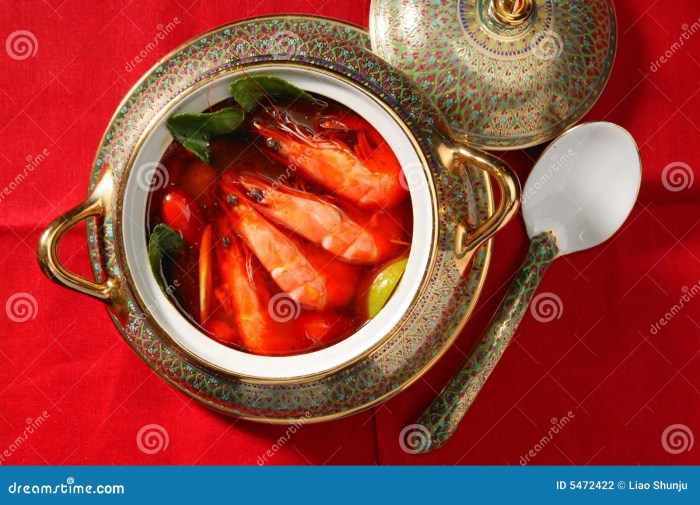
Tom Yum Koong, a vibrant and flavorful Thai soup, offers a canvas for culinary creativity. Chefs and home cooks alike have explored numerous variations, incorporating diverse ingredients and techniques to elevate this classic dish. From subtle tweaks to bold reinventions, the evolution of Tom Yum Koong reflects the adaptability of Thai cuisine and the constant pursuit of new flavor profiles.
Classic Tom Yum Koong Recipe
This recipe captures the essence of traditional Tom Yum Koong, balancing spicy, sour, and savory notes.
- Ingredients:
- 1.5 liters of chicken or vegetable broth
- 100 grams of fresh shrimp, peeled and deveined
- 1 lemongrass stalk, bruised
- 2 kaffir lime leaves, torn
- 1 galangal root, thinly sliced
- 1 red chili pepper, sliced
- 4 tablespoons of fish sauce
- 2 tablespoons of lime juice
- 2 tablespoons of sugar
- 1/2 cup chopped cilantro
- 1/4 cup chopped green onions
- Instructions:
- Bring the broth to a boil in a large pot. Add the lemongrass, kaffir lime leaves, galangal, and chili pepper. Reduce heat and simmer for 10 minutes.
- Add the shrimp, fish sauce, lime juice, and sugar. Stir to combine and cook until the shrimp turn pink, about 3 minutes.
- Stir in the cilantro and green onions. Serve immediately.
Tom Yum Koong with Coconut and Mango
This variation adds a touch of sweetness and creaminess, complementing the traditional flavors.
- Ingredients:
- 1 liter of coconut milk
- 100 grams of fresh shrimp, peeled and deveined
- 1 lemongrass stalk, bruised
- 2 kaffir lime leaves, torn
- 1 galangal root, thinly sliced
- 1 red chili pepper, sliced
- 2 tablespoons of fish sauce
- 2 tablespoons of lime juice
- 1 ripe mango, diced
- 1/4 cup chopped cilantro
- 1/4 cup chopped green onions
- Instructions:
- Bring the coconut milk to a simmer in a large pot. Add the lemongrass, kaffir lime leaves, galangal, and chili pepper. Simmer for 5 minutes.
- Add the shrimp, fish sauce, lime juice, and mango. Stir to combine and cook until the shrimp turn pink, about 3 minutes.
- Stir in the cilantro and green onions. Serve immediately.
Tom Yum Koong Recipe Collection
The versatility of Tom Yum Koong allows for endless variations, catering to different palates and dietary preferences. Here are some notable examples:
- Tom Yum Koong with Mushrooms:A vegetarian option using shiitake, oyster, or other flavorful mushrooms.
- Tom Yum Koong with Tofu:A protein-rich alternative using firm or silken tofu.
- Tom Yum Koong with Chicken:Incorporating shredded chicken adds a savory dimension.
- Tom Yum Koong with Seafood:Combining different seafood like scallops, mussels, or fish.
- Tom Yum Koong with Vegetables:Adding vegetables like bell peppers, zucchini, or eggplant for extra texture and flavor.
- Spicy Tom Yum Koong:Increasing the amount of chili peppers for a fiery kick.
- Mild Tom Yum Koong:Omitting or reducing the chili peppers for a less spicy version.


